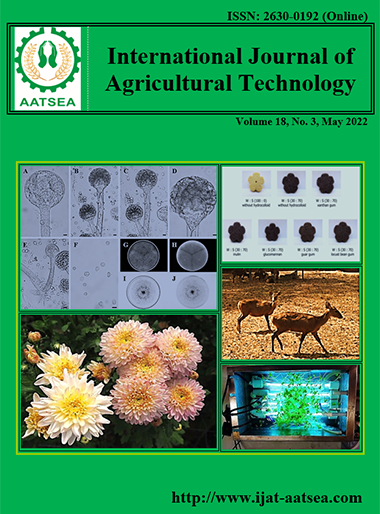Kinetic reduction of UV-C against Salmonella Typhimurium contaminated on radish sprouts (Raphanus sativus L.)
Main Article Content
Abstract
Consumer demand for fresh, healthy and contain large amounts of nutrious products has significantly increased the minimally processed ready-to-eat (RTE) vegetable. Sprouts are primary recognized as RTE. Unfortunathely, the frequency of reports about foodborne outbreaks resulted form sprouts consumption has increased. Interventions were highly required to minimize the contamination. This study presented the kinetic reduction of Salmonella Typhimurium contaminated on Radish sprouts using UV-C at 3.2 to 12.8 W/m3 under different washing systems. The reduction of S. Typhimurium increased when the intensity of UV-C increased. UV-C at 12.8 W/m3 for 30 min in dynamic washing system reduced the population of S. Typhimurium on Radish sprouts around 2.0 Log10CFU.g-1 with different statistical significance (p≤0.05). In addition, the kinetic reduction of S. Typhimurium on Radish sprouts was studied. The highest intensity of UV-C at 12.8 W/m3 demonstrated the highest rate of reduction (k-value) against S. Typhimurium. The highest k-value was 6.7x10-3 ln CFU.g-1.min-1 under dynamic washing system. However, the effect of low temperature indicated that the reduction rate was not depended on the change of temperature. Conclusively, the reduction effect of UV-C was increased when the intersity of UV-C and contact time increased. Moreover, the temperature had an ineffectiveness on the reduction of S. Typhimurium contaminated on Radish sprouts. Therefore, UV-C with different washing systems might be alternated for safety use the radish sprouts process.
Article Details

This work is licensed under a Creative Commons Attribution-NonCommercial-NoDerivatives 4.0 International License.
References
Birmpa, A., Sfika, V. and Vantarakis, A. (2013). Ultraviolet light and Ultrasound as non-thermal treatments for the inactivation of microorganisms in fresh ready-to-eat foods. International Journal of Food Microbiology, 167:96-102.
Buma, A. G. J., Boelen, P. and Jeffrey, W. H. (2003). UVR-induced DNA damage in aquatic organism. 1st ed UV Effects in Aquatic Organisms and Ecosystems.
Butot, S., Cantergiani, F., Moser, M., Jean, J., Lima, A., Michot, L. and Zuber, S. (2018). UV-C inactivation of foodborne bacterial and viral pathogens and surrogates on fresh and frozen berries. International Journal of Food Microbiology, 275:8-16.
Chun, H.-H., Kim, J.-Y., and Song, K. B. (2010). Inactivation of foodborne pathogens in ready-to-eat salad using UV-C irradiation. Food Science and Biotechnology, 19:547-551.
Escalona, V. H., Aguayo, E., Martínez-Hernández, G. B. and Artés, F. (2010). UV-C doses to reduce pathogen and spoilage bacterial growth in vitro and in baby spinach. Postharvest Biology and Technology, 56:223-231.
FDA (Food and Drug Administration) (2017). Ultraviolet (UV) Radiation. [online] Available at https://www.fda.gov/radiation-emitting-products/tanning/ultraviolet-uv-radiation.
Gardner, D. W. M. and Shama, G. (2000). Modeling UV-Induced Inactivation of Microorganisms on Surfaces. Journal of Food Protection, 63:63-70.
Gouma, M., Gayán, E., Raso, J., Condón, S. and Álvarez I. (2015). UV-Heat Treatments for the Control of Foodborne Microbial Pathogens in Chicken Broth. BioMed Research International, 2015:1-12.
Guo, S., Huang, R. and Chen, H. (2017). Application of water-assisted ultraviolet light in combination of chlorine and hydrogen peroxide to inactivate Salmonella on fresh produce. International Journal of Food Microbiology, 257:101-109.
Ha, J. W., Back, K. H., Kim, Y. H. and Kang, D. H. (2016). Efficacy of UV-C irradiation for inactivation of food-borne pathogens on sliced cheese packaged with different types and thicknesses of plastic films. Food Microbiology, 57 :172-177.
Kim, Y. H., Jeong, S. G., Back, K. H., Park, K. H., Chung, M. S. and Kang, D. H. (2013). Effect of various conditions on inactivation of Escherichia coli O157:H7, Salmonella Typhimurium, and Listeria monocytogenes in fresh-cut lettuce using ultraviolet radiation. International Journal of Food Microbiology, 166:349-355.
Lee, G., Kim, Y., Kim, H., Beuchat, L. R. and Ryu, J. H. (2018). Antimicrobial activities of gaseous essential oils against Listeria monocytogenes on a laboratory medium and radish sprout. International Journal of Food Microbiology, 265:49-54.
Ngadi, M., Smith, J. P. and Cayouette, B. (2003). Kinetics of ultraviolet light inactivation of Escherichia coli O157:H7 in liquid foods. Journal of the Science of Food and Agriculture, 83:1551-1555.
Rajkowski, K. T. and Thayer, D. W. (2000). Reduction of Salmonella spp. and Strains of Escherichia coli O157:H7 by Gamma Radiation of Inoculated Sprouts. Journal of Food Protection, 63:871-875.
Selma, M. V., Allende, A., López-Gálvez, F., Conesa, M. A. and Gill, M. I. (2008). Disinfection potential of ozone, ultraviolet-C and their combination in wash water for the fresh-cut vegetable industry. Food Microbiology, 25:809-814.
Stermer, R. A., Lasater-Smith, M. and Brasington, C. F. (1987). Ultraviolet Radiation—An Effective Bactericide for Fresh Meat. Journal of Food Protection, 50:108-111.
Taormina, P. J., Beuchat, L. R. and Slutsker, L. (1999). Infections Associated with Eating Seed Sprouts: An International Concern. Emerging Infectious Diseases, 5:626-634.
Warriner, K., Huber, A., Namvar, A., Fan, W. and Dunfield, K. (2009). Recent advances in the microbial safety of fresh fruits and vegetables. Adavances in Food and Nutrition Research, 57:155-208.
Yang, Y., Meier, F., Ann, J., Yuan, W., Lee Pei Sze, V., Chung, H. and Y, H. (2013). Overview of Recent Events in the Microbiological Safety of Sprouts and New Intervention Technologies. Comprehensive Reviews in Food Science and Food Safety, 12:265-280.
Zhang, C., Lu, Z., Li, Y., Shang, Y., Zhang, G. and Cao, W. (2011). Reduction of Escherichia coli O157:H7 and Salmonella enteritidis on mung bean seeds and sprouts by slightly acidic electrolyzed water. Food Control, 22:792-796.


